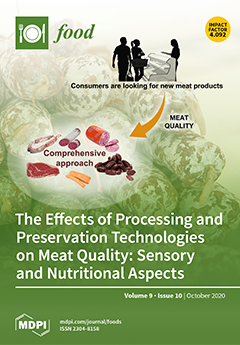Open AccessReview
Detection of Bacterial Pathogens and Antibiotic Residues in Chicken Meat: A Review
by
Harsh Kumar, Kanchan Bhardwaj, Talwinder Kaur, Eugenie Nepovimova, Kamil Kuča, Vinod Kumar, Shashi Kant Bhatia, Daljeet Singh Dhanjal, Chirag Chopra, Reena Singh, Shivani Guleria, Tek Chand Bhalla, Rachna Verma and Dinesh Kumar
Cited by 16 | Viewed by 7197
Abstract
Detection of pathogenic microbes as well as antibiotic residues in food animals, especially in chicken, has become a matter of food security worldwide. The association of various pathogenic bacteria in different diseases and selective pressure induced by accumulated antibiotic residue to develop antibiotic
[...] Read more.
Detection of pathogenic microbes as well as antibiotic residues in food animals, especially in chicken, has become a matter of food security worldwide. The association of various pathogenic bacteria in different diseases and selective pressure induced by accumulated antibiotic residue to develop antibiotic resistance is also emerging as the threat to human health. These challenges have made the containment of pathogenic bacteria and early detection of antibiotic residue highly crucial for robust and precise detection. However, the traditional culture-based approaches are well-comprehended for identifying microbes. Nevertheless, because they are inadequate, time-consuming and laborious, these conventional methods are not predominantly used. Therefore, it has become essential to explore alternatives for the easy and robust detection of pathogenic microbes and antibiotic residue in the food source. Presently, different monitoring, as well as detection techniques like PCR-based, assay (nucleic acid)-based, enzyme-linked immunosorbent assays (ELISA)-based, aptamer-based, biosensor-based, matrix-assisted laser desorption/ionization-time of flight mass spectrometry-based and electronic nose-based methods, have been developed for detecting the presence of bacterial contaminants and antibiotic residues. The current review intends to summarize the different techniques and underline the potential of every method used for the detection of bacterial pathogens and antibiotic residue in chicken meat.
Full article
►▼
Show Figures






